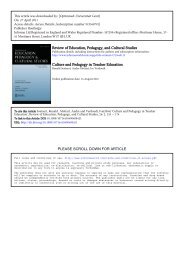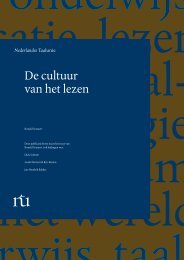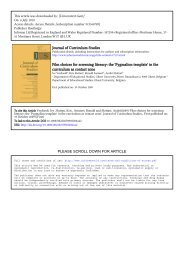a view informed by the problems of traditional literacy in a digital age
a view informed by the problems of traditional literacy in a digital age
a view informed by the problems of traditional literacy in a digital age
You also want an ePaper? Increase the reach of your titles
YUMPU automatically turns print PDFs into web optimized ePapers that Google loves.
Downloaded <strong>by</strong> [University <strong>of</strong> Gent] at 06:46 09 December 2011<br />
Ronald Soetaert & Bart Bonamie<br />
is an <strong>in</strong>tellectual culture able to transform its own premises as fast as our<br />
technologies are transform<strong>in</strong>g us’ (Brockman, 1995).<br />
More and more educators realise that <strong>the</strong>y have to face <strong>the</strong> challenge<br />
<strong>of</strong> <strong>in</strong>tegrat<strong>in</strong>g <strong>in</strong>formation technology tools <strong>in</strong> teach<strong>in</strong>g and learn<strong>in</strong>g, and <strong>in</strong><br />
manag<strong>in</strong>g educational <strong>in</strong>stitutions. Indeed, <strong>the</strong>se tools extend learn<strong>in</strong>g<br />
outside <strong>the</strong> <strong>in</strong>stitutions as schools and classrooms. Teachers realise <strong>the</strong>y<br />
have to change <strong>the</strong>ir roles. In <strong>the</strong> next part we will try to problematise <strong>the</strong>se<br />
new roles.<br />
New Roles for Teachers<br />
Technology to Prepare Teachers<br />
In addition to langu<strong>age</strong> and technology, our LTOL project also focused on<br />
teacher tra<strong>in</strong><strong>in</strong>g. From a technological perspective, <strong>the</strong>re is a grow<strong>in</strong>g<br />
consensus – based on research – that teacher tra<strong>in</strong><strong>in</strong>g is <strong>the</strong> key process <strong>in</strong><br />
<strong>the</strong> successful <strong>in</strong>corporation <strong>of</strong> technology <strong>in</strong>to <strong>the</strong> curriculum. Research<br />
also shows us that very <strong>of</strong>ten teachers teach <strong>the</strong> same way <strong>in</strong> which <strong>the</strong>y<br />
were taught <strong>the</strong>mselves. So, <strong>the</strong> best moment to <strong>in</strong>troduce (student) teachers<br />
to technology is <strong>the</strong> moment <strong>the</strong>y are be<strong>in</strong>g taught to become teachers, <strong>the</strong><br />
moment <strong>the</strong>y are socialised <strong>in</strong> <strong>the</strong>ir new pr<strong>of</strong>essional role. We also know<br />
that <strong>the</strong>re is a difference between prepar<strong>in</strong>g teachers to use technology and<br />
us<strong>in</strong>g technology to prepare teachers (Harr<strong>in</strong>gton, 1991).<br />
Role-chang<strong>in</strong>g<br />
Today, <strong>the</strong>re is a tendency towards self-directed, autonomous, lifelong<br />
learn<strong>in</strong>g, emphasis<strong>in</strong>g <strong>the</strong> fact that mean<strong>in</strong>g is constructed <strong>in</strong>dividually and<br />
socially. As <strong>the</strong> methodology, <strong>the</strong> curriculum, <strong>the</strong> students and <strong>the</strong> school<br />
are chang<strong>in</strong>g, so too is <strong>the</strong> role <strong>of</strong> <strong>the</strong> teacher.<br />
Teachers no longer control everyth<strong>in</strong>g that happens <strong>in</strong> <strong>the</strong> classroom;<br />
<strong>the</strong>ir ma<strong>in</strong> function is to help <strong>the</strong> learners develop <strong>the</strong>ir autonomy. This is<br />
best done <strong>by</strong> help<strong>in</strong>g <strong>the</strong>m to choose appropriate and adequate learn<strong>in</strong>g<br />
materials, and <strong>by</strong> expla<strong>in</strong><strong>in</strong>g learn<strong>in</strong>g strategies and techniques. This general<br />
constructive approach to teach<strong>in</strong>g is also deeply <strong>in</strong>fluenced <strong>by</strong> <strong>the</strong><br />
<strong>in</strong>troduction <strong>of</strong> new technology. Teachers will have to be more responsive to<br />
<strong>the</strong> new characteristics <strong>of</strong> an on-l<strong>in</strong>e computer environment. The new<br />
teach<strong>in</strong>g methods are complex and labour-<strong>in</strong>tensive. Indeed, <strong>the</strong> shift<strong>in</strong>g<br />
functions pose complex challenges to teachers. A new paradigm creates new<br />
roles for teachers. We selected four major roles (focus<strong>in</strong>g on <strong>the</strong> relation<br />
with new technology). These are now briefly described.<br />
Coach, Facilitator. The <strong>in</strong>troduction <strong>of</strong> a more constructive approach <strong>of</strong>ten<br />
precipitates a fundamental change <strong>in</strong> <strong>the</strong> forms <strong>of</strong> <strong>in</strong>teraction between<br />
teachers and students, and among students <strong>the</strong>mselves. There is also a<br />
140





